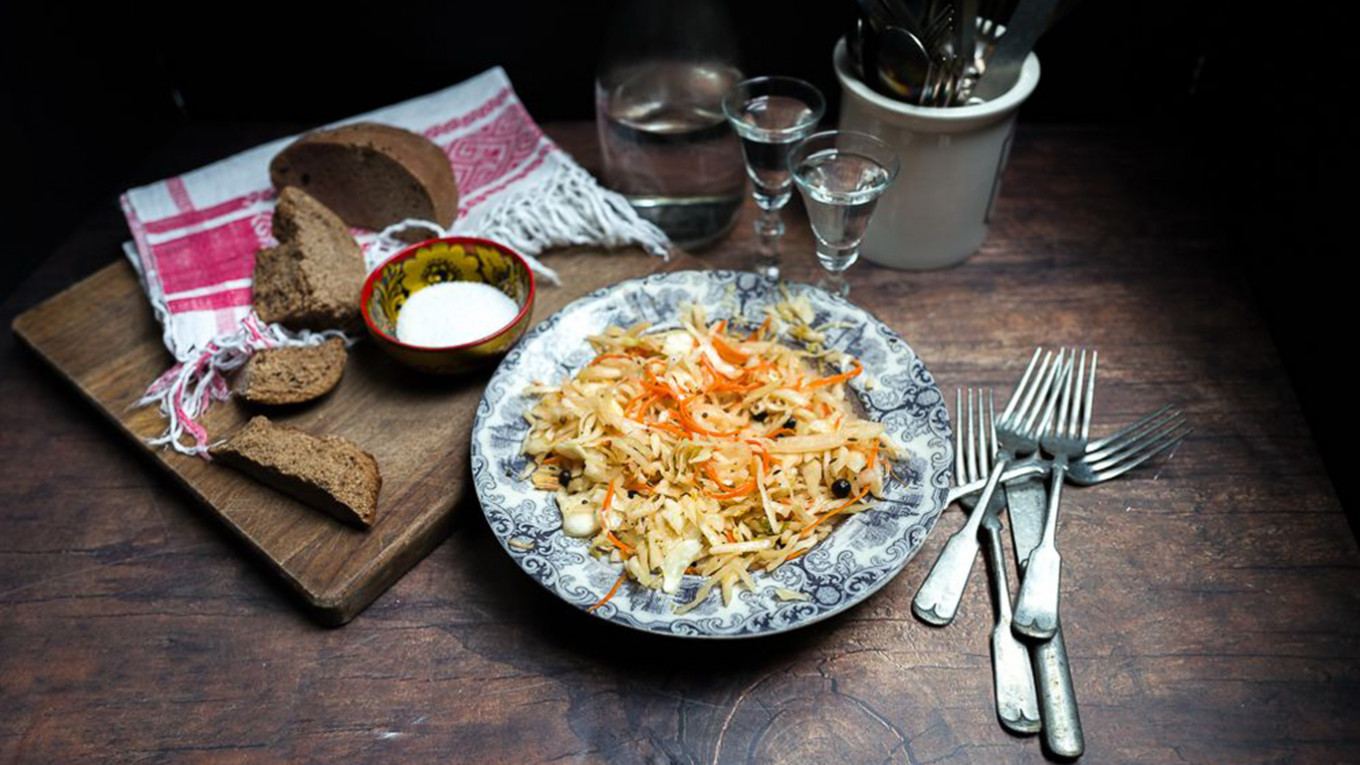Trucks piled high with cabbages backing up to supermarkets and markets and the gaping holes on the salt shelves announce autumn in Russia as much as do the muted yellow beauty of the damp leaves and the wispy fog on the river before the morning sun burns it off. Russians roll up their sleeves and contemplate the annual ritual of putting up fermented cabbage for the winter.
Of the five basic flavors — bitter, sweet, umami or savory, salty, and sour—Russian cuisine relies heavily on the sour notes from the rich array of fermented dairy, grains, and vegetables. There is something baked (or brined in this case) into the Russian DNA that craves these briny, mouth-puckering tastes. Perhaps it is nostalgia for a centuries-old tradition or an even older survival instinct: in the continuous cycle of feast and famine that is life in Russia, crocks of fermented cabbage with its dense nutrients have often meant the difference between starvation and subsistence.
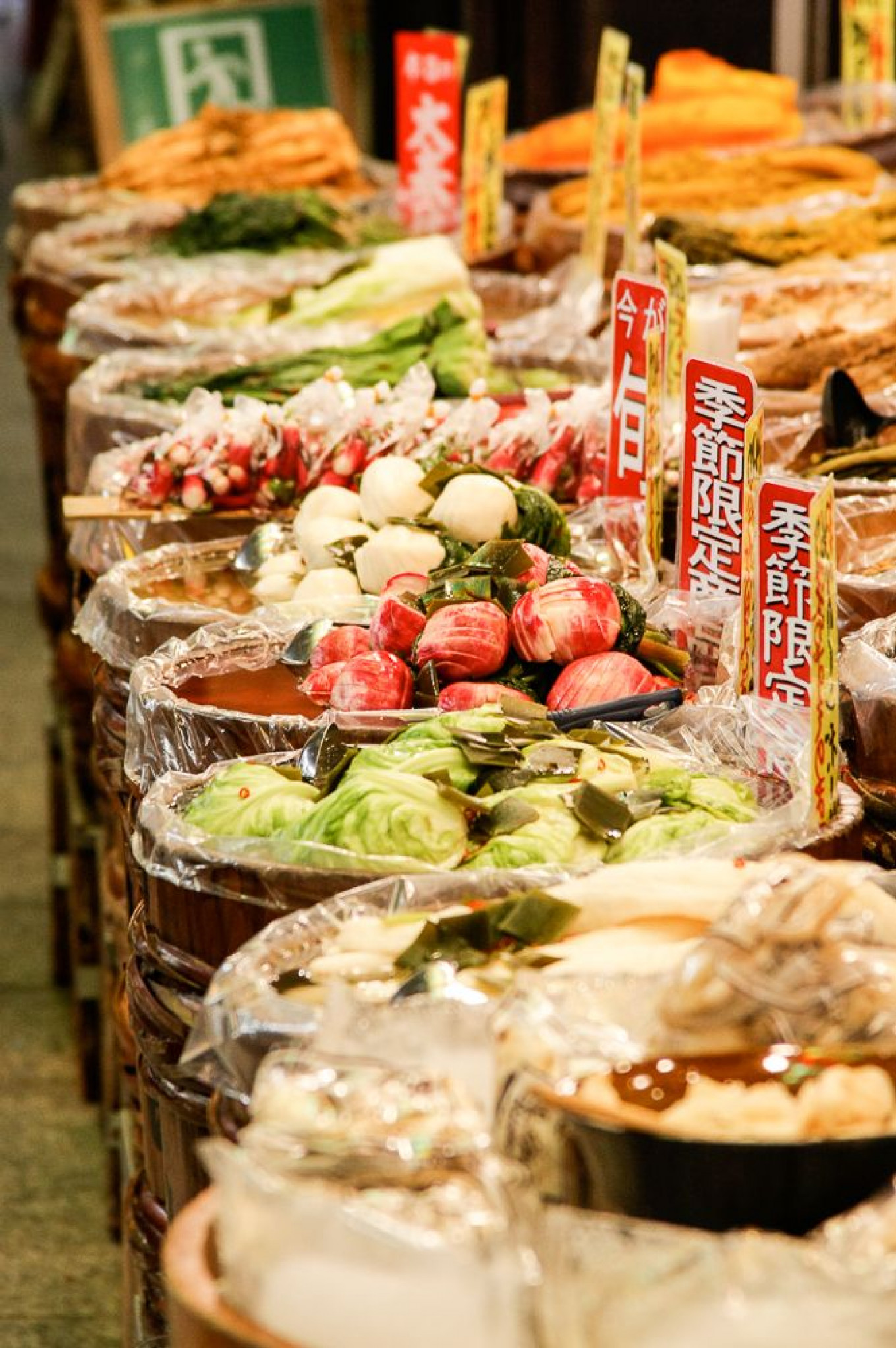
The Ancient Art of Fermentation
Mankind probably discovered fermentation by accident, but this fortuitous accident occurred early in our history and played a big part in the march of civilization by making it possible to preserve perishable food. Humans have never looked back: in 7000 BCE, the Chinese were brewing a primitive version of beer with rice and honey, around 6000 BCE, Georgians began perfecting the art of viniculture, the Egyptians tamed wild yeast to keep leavened bread on the tables around 4000 BCE, and in 2000 BCE, we get the first recorded instance of pickled cucumbers.
In the Mediterranean, fermentation preserved the all-important olive and other staples throughout the Roman world. This makes it hard to pinpoint just when or how the technique of fermentation came to Russia. It could have traveled in the ninth and tenth centuries up the Volga and Dnieper with Arab or Byzantine traders or possibly with the thirteenth-century Mongol invaders, who thundered west across the Eurasian steppe and occupied the lands of Rus until the mid-fifteenth century. What we do know is that by the Middle Ages, fermenting vegetables was an integral part of the Russian agricultural cycle, as is clear from the Domostroi, that authoritative sixteenth-century guide to household management, which assumes a universal and complete mastery of the technique.
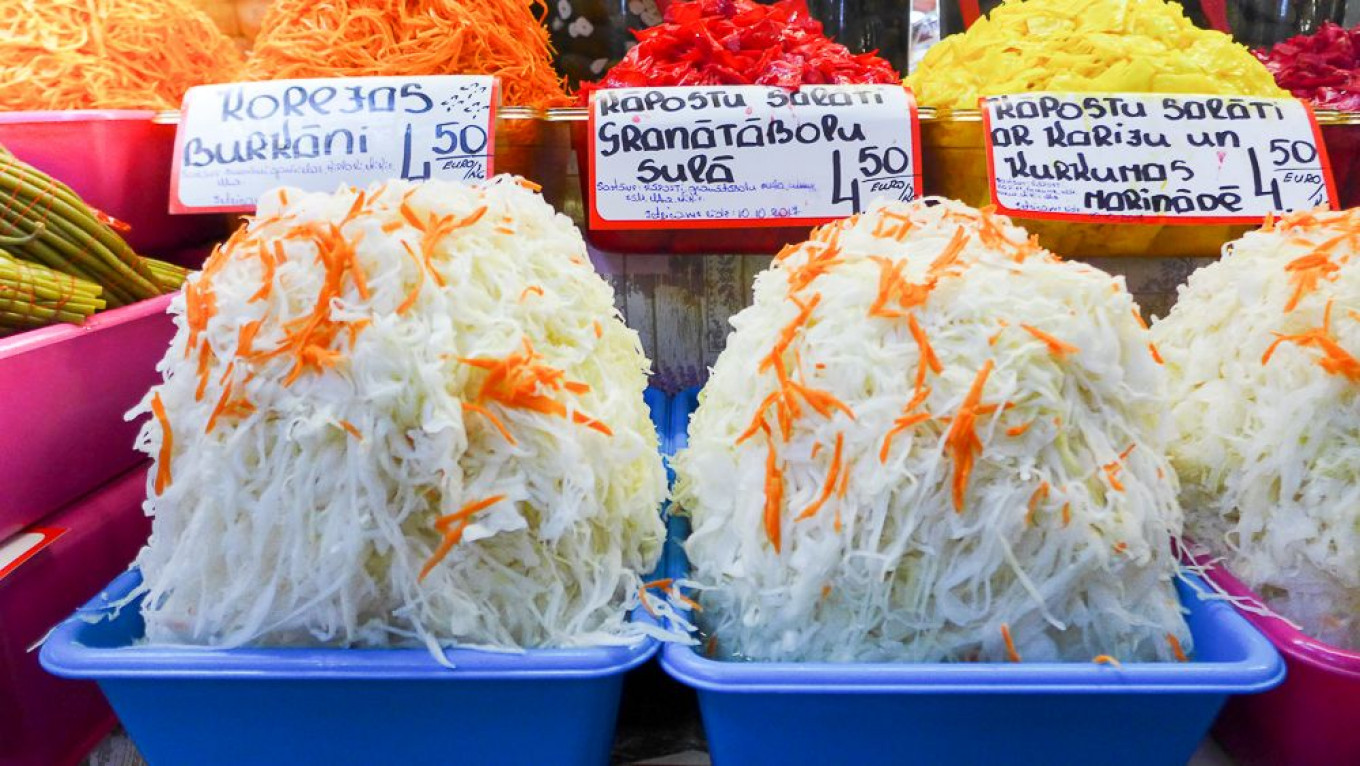
It took me many years to work up the courage to try fermenting cabbage myself. Laziness was a factor: we are spoiled for choice in Russia, where glistening mounds of aromatic cabbage are the centerpiece of the sprawling pickle sections of city markets — one can while away a pleasant morning enjoying generous free samples from the affable market hawkers.
Timidity was also involved: fermenting cabbage is a serious business in Russia — almost a contact sport — and I certainly perceived it as one of those realms into which foreigners wander at their peril. But eventually parsimony prevailed; the raw ingredients involved — salt, cabbage, and spices — are affordable, and the intangibles of time and temperature are free. And the incentive to enjoy a steady supply of one of the key ingredients in Russian soups and pies was overwhelming. So I set out to master the technique.
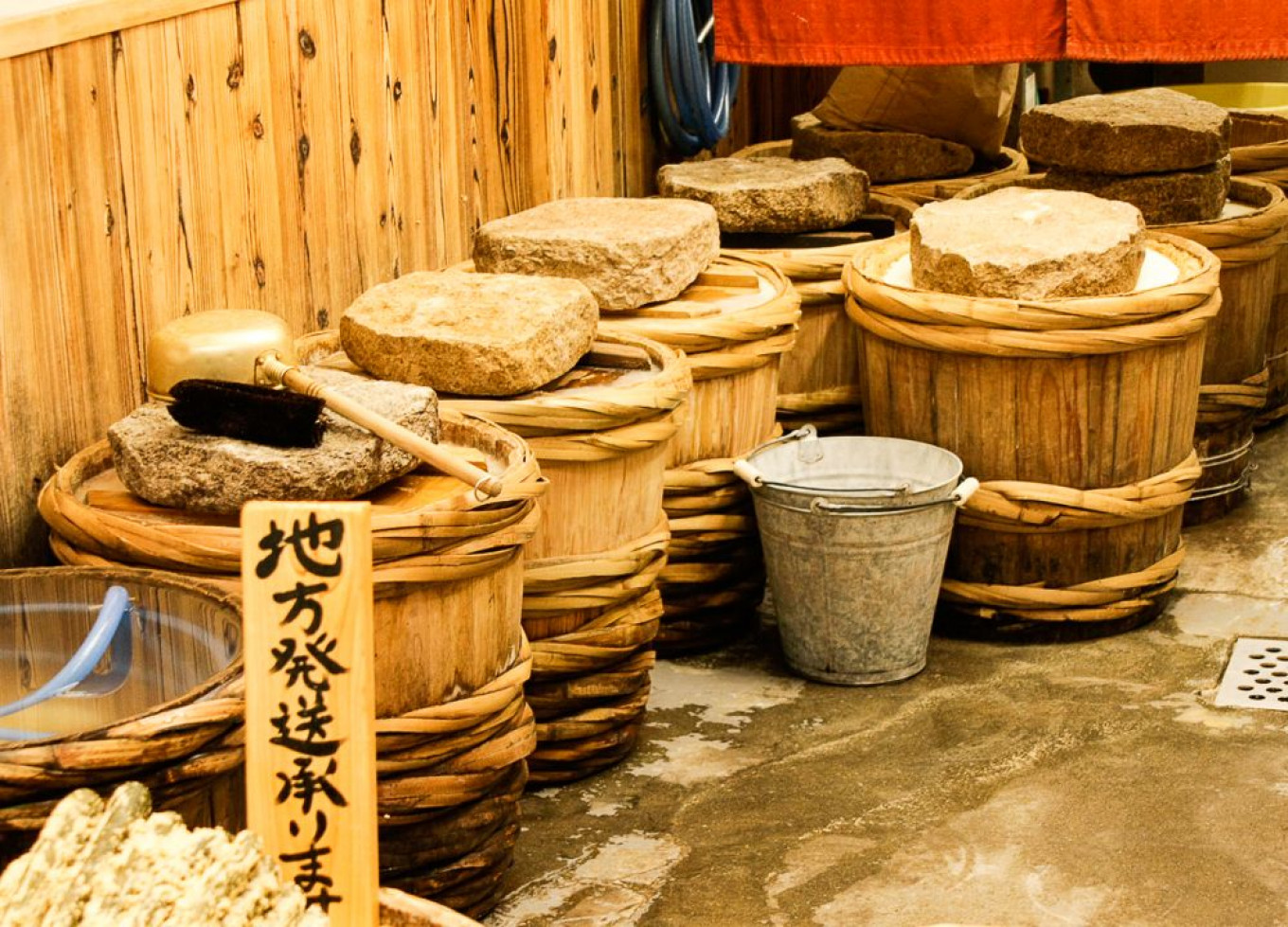
A Short Chemistry Lesson
Fermentation is an anaerobic process by which lactic acid bacteria or lactobacilli convert the natural sugars in foodstuffs into acids, producing by-products of carbon dioxide and ethanol. While the pre-industrial appeal of fermented vegetables was wholly practical — to preserve perishable foods and extend their shelf life — by the beginning of the twentieth century the health benefits were also emerging. Elie Metchnikoff observed in his influential “Prolongation of Life” that countries such as Georgia and Bulgaria, where the diet included frequent consumption of fermented foods, enjoyed noticeably longer life expectancy. We now know that fermented foods are packed with nutrients, vitamins, and essential to promoting a healthy gut, which accounts for their return to popularity in Western cuisine in the past two decades.
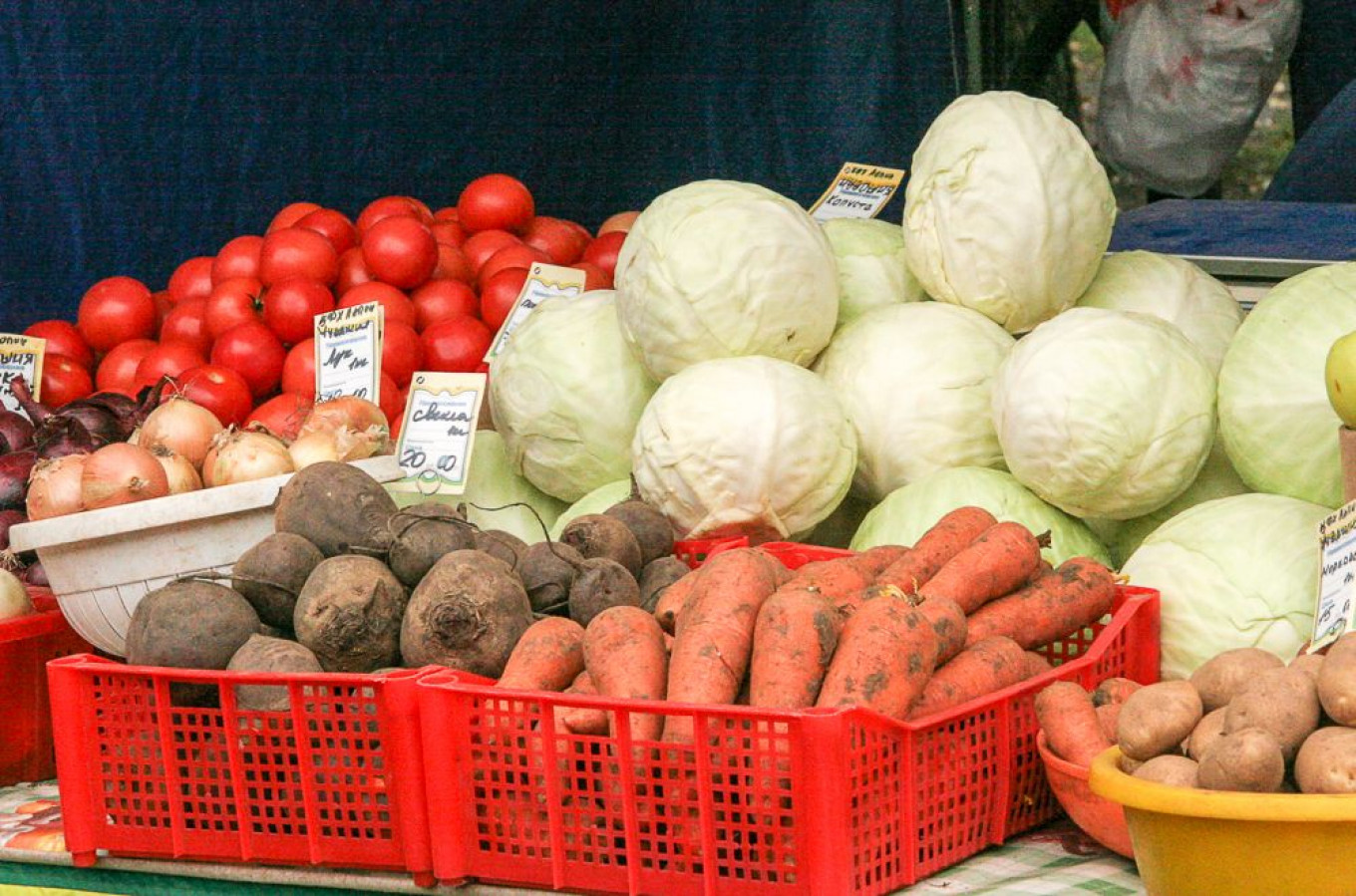
Ingredients
Classic Russian fermented cabbage pairs cabbage and carrots with a few spices. For years I thought the carrot was merely an aesthetic or flavor choice, but when I delved into the science of fermentation, I realized that the carrots were a deliberate choice because of their high sugar content. Adding a “feeder” that is high in sugar gives the lactobacilli more to work with, thus turbo-charging the fermentation process. But carrots aren’t the only feeder options: the tough core of a cabbage, cranberries, beets, apples, pineapple, quince, parsnips, and rutabagas all bolster the lactobacilli adding not only subtle flavor hints but also, in the case of beets and pineapples, vibrant and appealing colors.
This brings us to the question of spices. Asian recipes for fermented vegetables add heat with the addition of chili peppers and horseradish, but Russian cabbage tends not to be too spicy. Bay leaves and garlic are traditional flavors — and bay helps the cabbage keep its crunch. Fresh dill is common as are caraway seeds, coriander, mustard seeds, allspice, and dill seed. In the recipes below, I have played with other flavors to complement the choice of feeder. Let your imagination run wild here — cabbage is nothing if not a blank culinary canvas.
The Salt
Salt is one of two principal ingredients in these recipes, so this is not a moment to skimp on it. Iodized salt can interfere with the fermentation process; instead choose the best quality natural sea salt you can get your hands on; think of it as providing soldiers with an extra sturdy pair of boots. The amount of salt you add to fermented cabbage is highly subjective, but a good general rule of thumb is 2% of the combined weight of the shredded cabbage, feeder, and spices. If you don’t have a kitchen scale, calculate the amount by weighing the cabbage at the grocery store or market and converting 2% into teaspoons or tablespoons (1 teaspoon = 4.2 grams, and 1 Tablespoon = 15 grams).
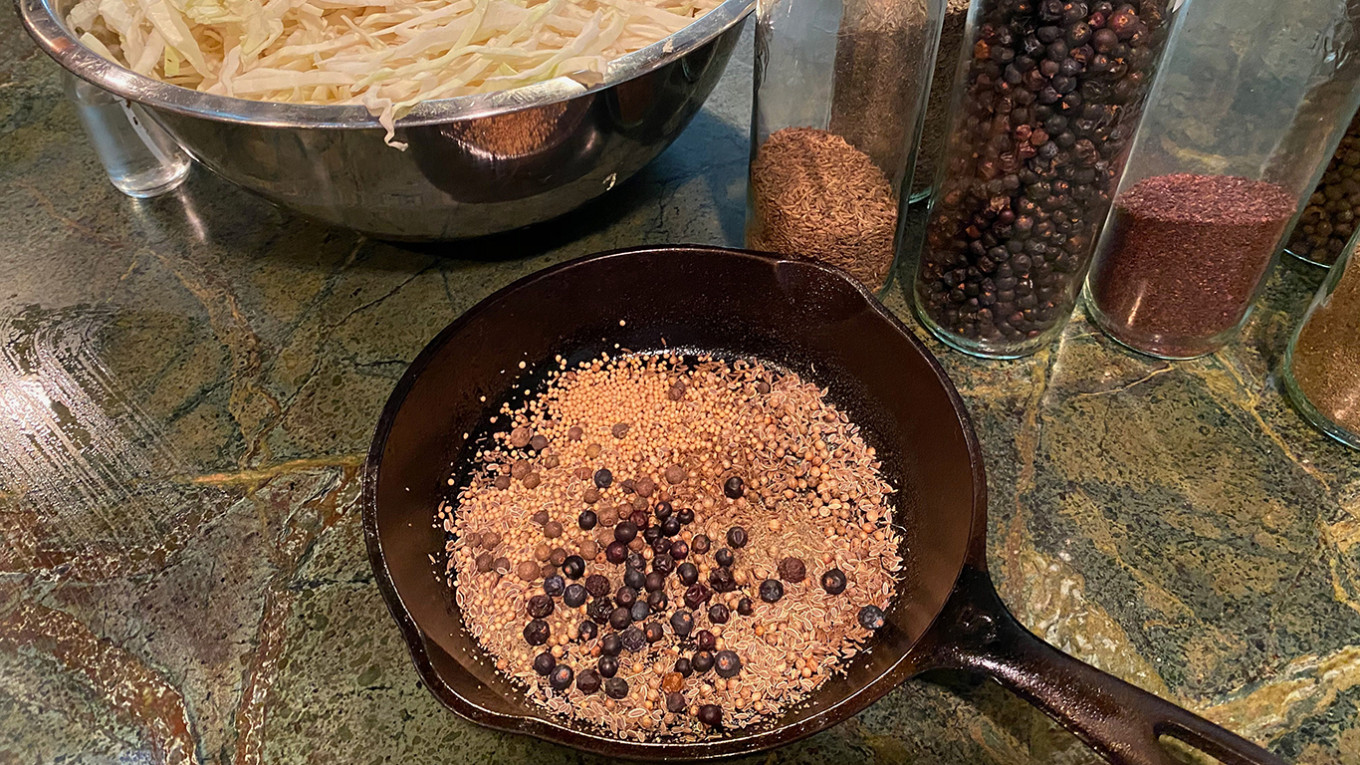
Equipment
Anaerobic processes require an environment devoid of oxygen. Ceramic crocks with water seals are popular in Japan, China, and Germany. Recently in America, special lids for canning jars with plastic airlocks have come into widespread use. Both systems allow pent up carbon dioxide to escape through tiny holes, but a water seal keeps the oxygen from getting into the mix. If you don’t have a crock or an airlock, a sturdy plastic bag filled with water placed carefully on top of the cabbage is an excellent substitute seal.
If you can’t rig up an airlock, find a jar with a tight lid and “burb” it every other day by cracking the lid open ever so slightly and quickly tightening it up again. This will allow the accumulated carbon dioxide to escape the container and let only the minimal amount of oxygen in.
Resist the temptation to race out and buy a lot of fancy fermenting kits, crocks, weights, and airlocks in an initial fit of enthusiasm. Remember that in Russia, they make marvelous fermented cabbage in a plain old metal or plastic bucket with a lid and a plate to weight the cabbage down. Start small, with 500-ml or 1-liter jars rather than traditional 3 or 5-liter containers. Choose a wide-mouth, non-reactive container (glass allows you to see what is going on) and find a weight that fits easily into the mouth of the container (a flat rock scrubbed well can work very well, as will a smaller jar or ceramic bowl).
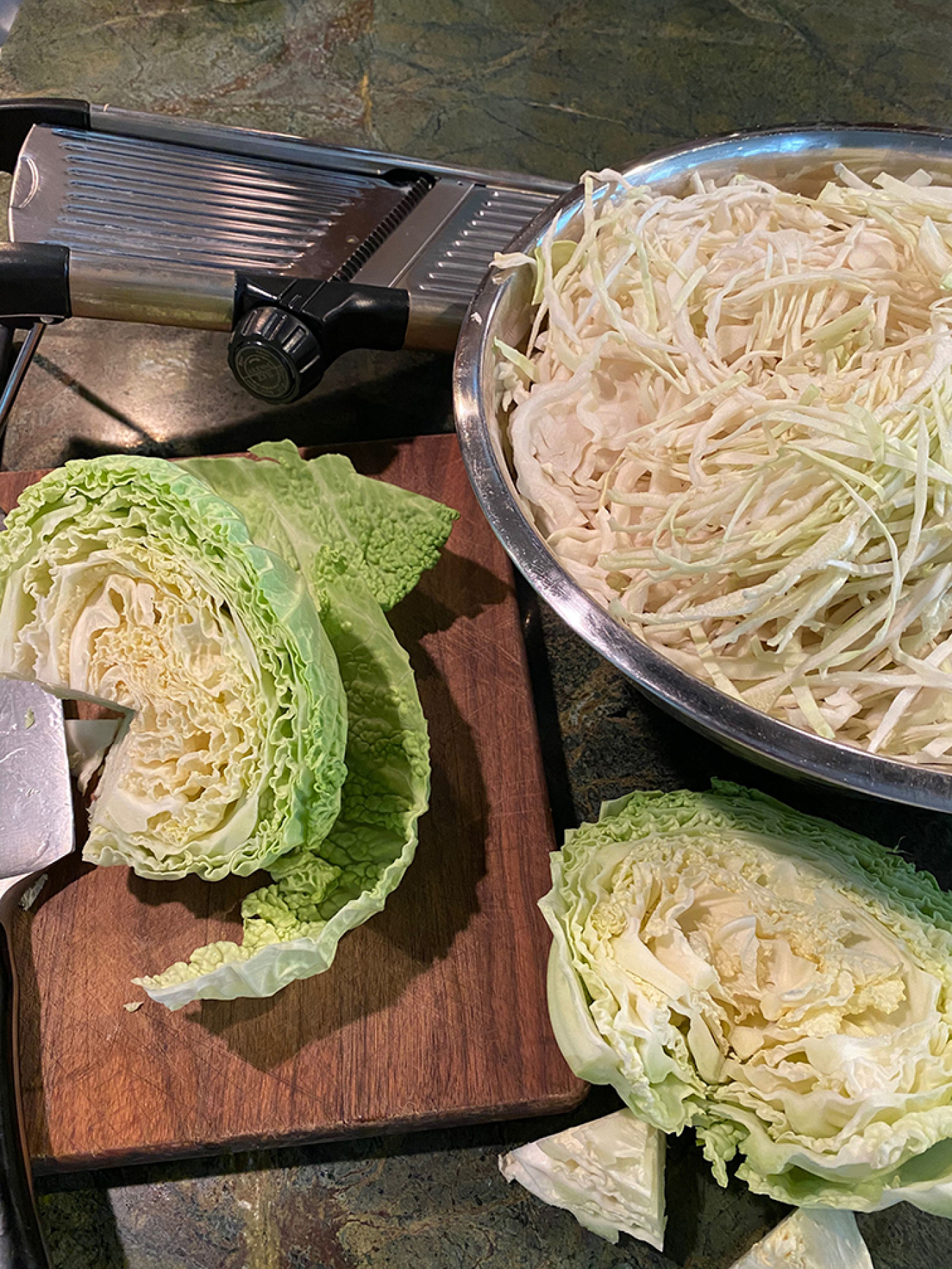
Shredding the cabbage into the desired long, thin strips appears to be a skill most Russians possess without knowing why — think of sophisticated factory boss Katya in the film “Moscow Doesn’t Believe in Tears” out at Antonina’s dacha shredding cabbage with a knife like she’s born to it, even as she bemoans the difficulties of a high-flying career woman to find a boyfriend. I don’t have this naturally born shredding skill in my DNA, so for me, a mandoline is a godsend. A pounder can also be an immense help. Look around your kitchen to find a suitable implement that can bash the cabbage, then help you pack the container tightly and dispel any air bubbles. A potato masher, wooden mallet, meat tenderizer, or large wooden spoon are all excellent options.
The Hard Part
The hardest and most hands-on part of making fermented cabbage is massaging it — always more time-consuming and exhausting than you expected, even with a pounder. To make this slightly easier, I toss the shredded cabbage with salt and let it stand for 30 minutes before I begin the massaging or the pounding. This enables the salt to break down the water in the cabbage and render it marginally easier to handle. It still takes a lot of elbow grease.
Hygiene, Hygiene, Hygiene
Pay close attention to hygiene during all stages of the fermenting process, but especially during the hands-on stage. Run your container through a full cycle of a dishwasher or scrub it with hot, soapy water and dry with a clean towel. Make sure your own hands and fingernails are spotless; any hostile bacteria will hinder the lactobacilli from their mission. Take care to remove any tough, dirty outer leaves of the cabbage, saving a few to cover the top of the cabbage, and if the head is gritty, give the shredded pieces a bath in a salad spinner.
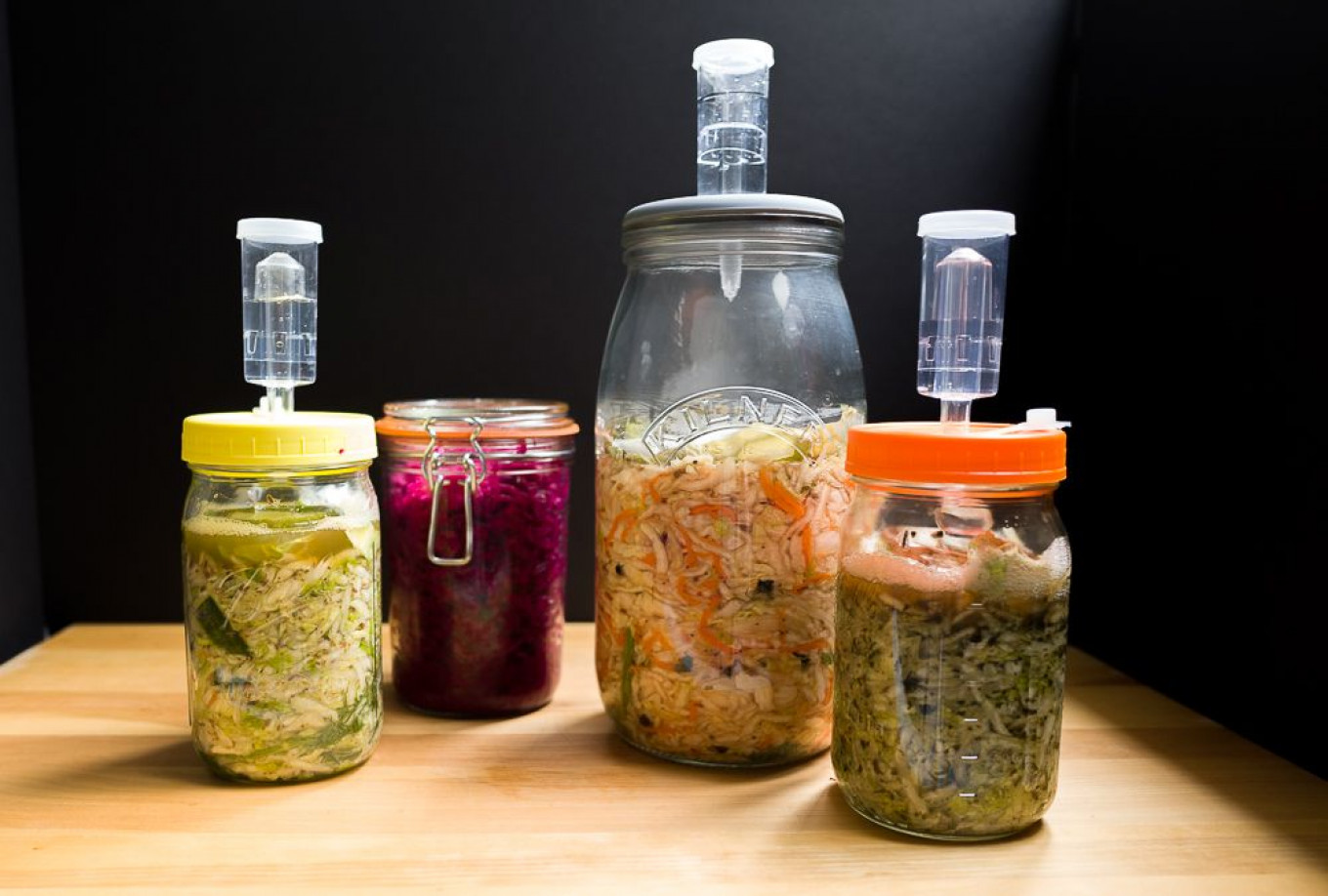
Weighting it Down
Once you have massaged and pounded the cabbage, liquid will leach out of the cabbage and the more of this the better. For effective fermentation, the packed cabbage needs to remain submerged under this liquid, and the tide will rise as the fermentation progresses. Fermentation weights ensure that the cabbage stays submerged; these can be special glass or clay weights that come with your crock or jar, or just a suitably sized and thoroughly scrubbed flat rock, a smaller jar filled with water or a plastic bag with glass marbles.
Temperature & Location
While the cabbage is fermenting, keep the container in a dark place, or at least out of direct sunshine, at a temperature that is no cooler than 60ºF (15ºC) and no hotter than 75ºF (23ºC).
Time
The greatest variable in this recipe is time: the longer the fermentation, the more acid the lactobacilli produce and thus the more intense the sour flavor. Always label your containers with the starting date so you can keep track of the number of days since you packed your cabbage.
After one or two days, the liquid at the top of the jar will increase and small bubbles will appear on the surface of the liquid. This is a sign that your fermentation is active and underway. As you become a more seasoned fermenter, you will develop a sixth sense about how long you should go. Once a week has passed, your cabbage should be sufficiently fermented to avoid spoilage and provide the probiotic benefits you seek. But you can keep going — sample your cabbage with a clean fork to see if you like the flavor and taste, mindful that the cabbage will become saltier, the sour taste more pronounced, and any flavors you’ve added will be amplified the longer you leave the cabbage. If you are happy with the taste, decant the cabbage into storage jars and refrigerate them. The cooler air will slow the fermentation down, but not halt it. Properly fermented cabbage should be good for several weeks in the refrigerator.
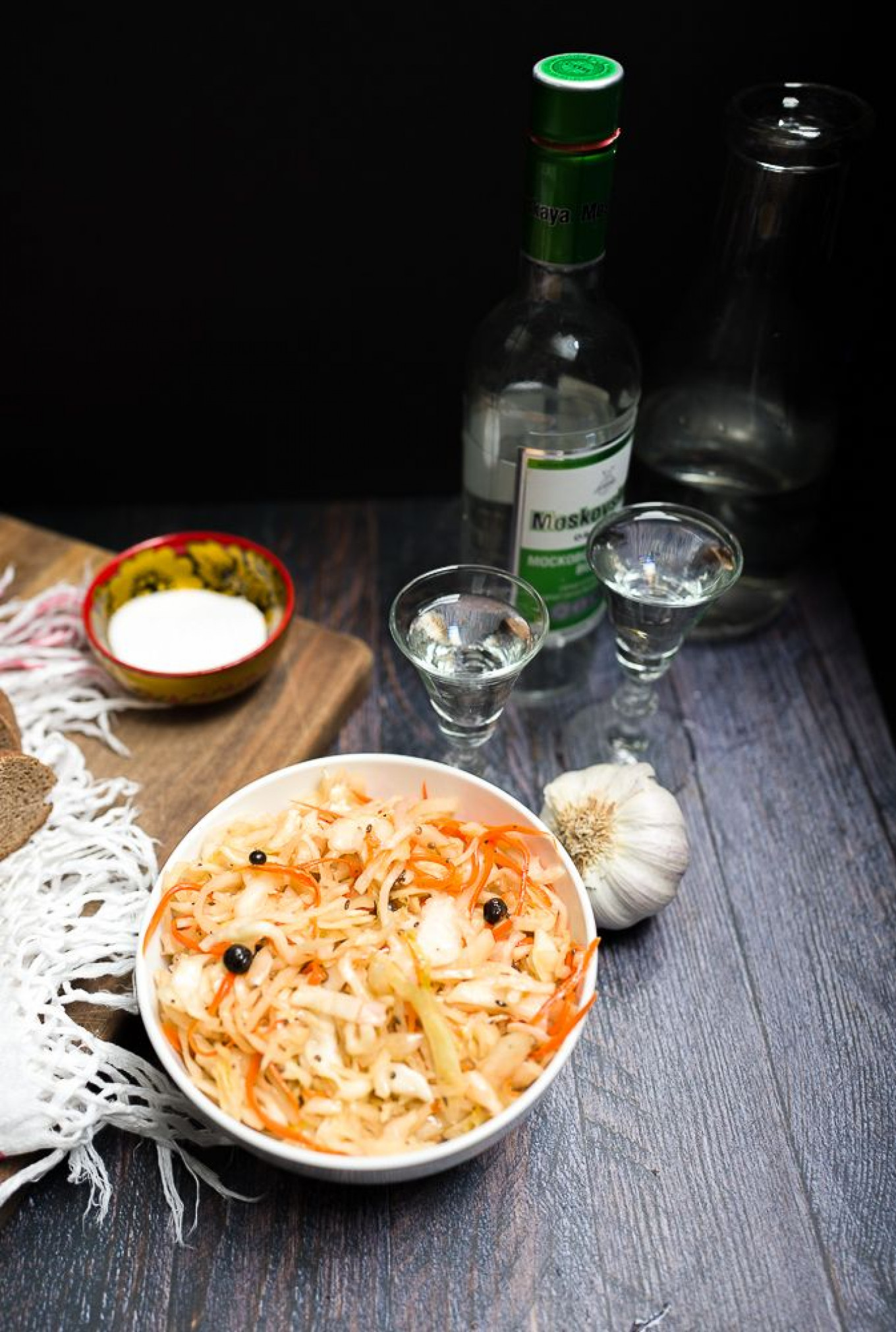
Uses of Fermented Cabbage
The most common way to consume fermented cabbage in Russia involves opening a bottle of vodka and forking the cabbage directly from the jar. A classic pairing and very delicious too. If, however, you are seeking to branch out, consider these other options:
- Add the cabbage to soups such as borscht, shchi, potato soup, rassolnik, and others to provide an authentic and essential sour note.
- Make the fermented cabbage into a salad by adding a few teaspoons of olive oil and some fresh vegetables such as shredded carrots, more cabbage, watercress, scallions, dill, and parsley. Toss to combine.
- Pair with salted meat such as pastrami, ham, smoked poultry, corned beef, or basturma in a sandwich.
- Add a generous spoonful to a grain bowl or noodle salad.
- Serve alongside potatoes, sausages, and a generous dollop of mustard for a hearty winter meal.
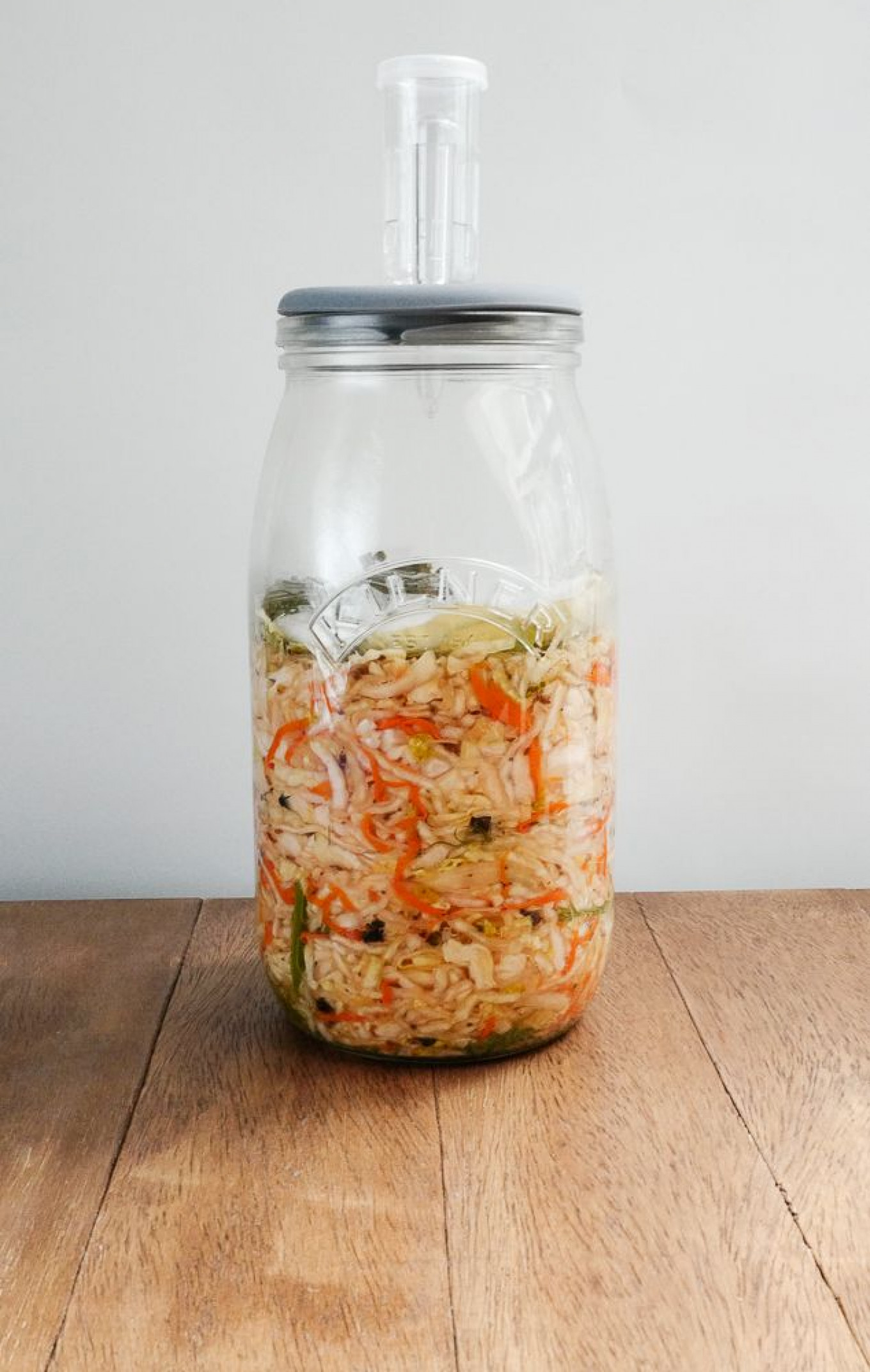
Classic Russian Kvashanaya Kapusta (Fermented Cabbage)
Ingredients
- 1 2-lb (1 kilo) head of conventional cabbage
- 2 carrots peeled and then julienned into thin strips
- 25 grams (1 ½ Tbsp) sea salt
- 2 bay leaves
- 2 cloves garlic peeled and grated
Spice Mix
- 1 tsp caraway seeds
- 1 tsp whole coriander seeds
- 1 tsp allspice berries
- 1 tsp dill seed
- ½ tsp black peppercorns
- 1 pinch dill pollen (optional but recommended!)
Instructions
- Remove the tough, outer layers of cabbage, then peel off a few large leaves and reserve for the top of the container.
- Use a sturdy knife to remove the tough core of the cabbage, then cut the cabbage into quarters. Slice the cabbage into long, thin strips using a knife or mandoline.
- Toss the shredded cabbage and carrots with the salt and let sit for 30 minutes.
- Toast the spices over low heat until the scent intensifies, let them cool, then grind them in a spice grinder or with a mortar and pestle.
- Massage the salt into the cabbage with your hands, rubbing the shredded cabbage between your fingers repeatedly until the cabbage is noticeably limper and expels liquid. If you have a kraut pounder or something like it, pound the cabbage to intensify this process. When you’ve done all you can, let the cabbage sit for another 45 minutes, covered with a clean towel.
- Add the spice mixture and toss well to combine, then pack the cabbage and any accumulated liquid, garlic, and bay leaves into a clean container, using a pounder to press down on the cabbage, and expel any air bubbles. Leave 2 centimeters of head space and enough room for the weight.
- Cut the reserved cabbage leaves to fit the width of your container and cover the cabbage, then add the weights on top. Affix your lid, and airlock if using. Label your fermentation container with the date.
- Set the container to ferment in a cool, dark place. If you are using a conventional lid without an airlock, “burp” the lid every other day by cracking it and shutting it quickly. This will allow the accumulated carbon dioxide to escape and avoid an explosion.
- When 7 days have passed, taste the cabbage for desired sourness, saltiness, and intensity of flavors. When you are happy with it, decant the cabbage into clean jars and refrigerate.
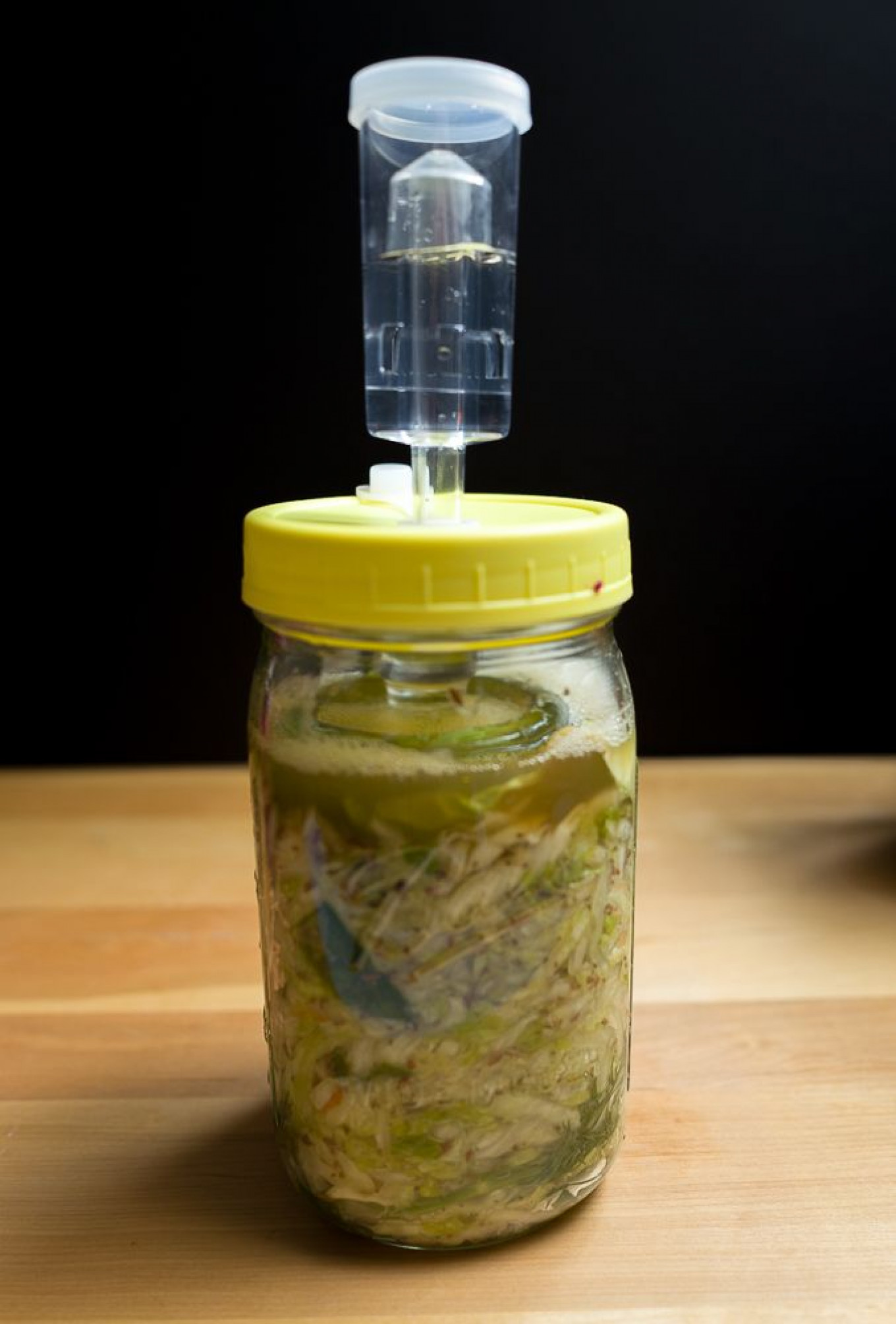
Dill Pickle Flavored Cabbage
This recipe, which has become a firm favorite with my family, was inspired by a recipe from farmsteady.com. It has a smooth taste with strong hints of dill pickles. It is marvelous on sandwiches, particularly turkey or cheese.
Ingredients
- 1 2-lb (1 kilo) head of conventional cabbage
- The peel of one large cucumber
- 20 grams (1½ Tbsp) of sea salt
- 2 bay leaves
- 2 cloves garlic peeled and grated
- 6 large fresh dill sprigs with stems and fronds
Spice Mix
- 1 tsp dill seed
- ½ tsp white peppercorns
- 1 ½ tsp caraway seed
- 1 pinch dill pollen (optional but recommended!)
Instructions
- Remove the tough, outer layers of cabbage, then peel off a few large leaves and reserve for the top of the container.
- Use a sharp knife to remove the tough core of the cabbage, then cut the cabbage into quarters.
- Grate the cabbage core on the largest holes of a box grater or in a food processor and use this as the feeder.
- Slice the cabbage into long, thin strips using a long knife or mandoline.
- Toss the shredded cabbage and grated core with the salt and let sit for 30 minutes.
- Toast the peppercorns, dill seeds, and caraway seeds over low heat until their scent intensifies, then grind them in a spice grinder or with a mortar and pestle.
- Massage the salt into the cabbage with your hands, rubbing the shredded cabbage between your fingers repeatedly until the cabbage is noticeably limper and is leaching liquid. If you have a kraut pounder or something like it, pound the cabbage to intensify this process. When you’ve done all you can, let the cabbage sit for another 45 minutes, covered with a clean towel.
- Add the spice mixture and pinch of dill pollen and toss well to combine. Pack the cabbage and any accumulated liquid, bay leaves, garlic, cucumber strips, dill sprigs, and garlic into a clean container, using a pounder to press down on the cabbage, expelling any air bubbles. Leave 2 centimeters of head space and enough room for the weight.
- Cut the reserved cabbage leaves to fit the width of your container and cover the cabbage, then add the weights, lid, and airlock if using. Label your fermentation container with the date.
- Set the container to ferment in a cool, dark place. If you are using a conventional lid without an airlock, “burp” the lid every other day by opening it slightly and shutting it quickly. This will allow the accumulated carbon dioxide to escape and avoid an explosion.
- When 7 days have passed, taste the cabbage for desired degree of sourness, saltiness, and intensity of flavors. When you are happy with the results, decant cabbage into clean jars and refrigerate.
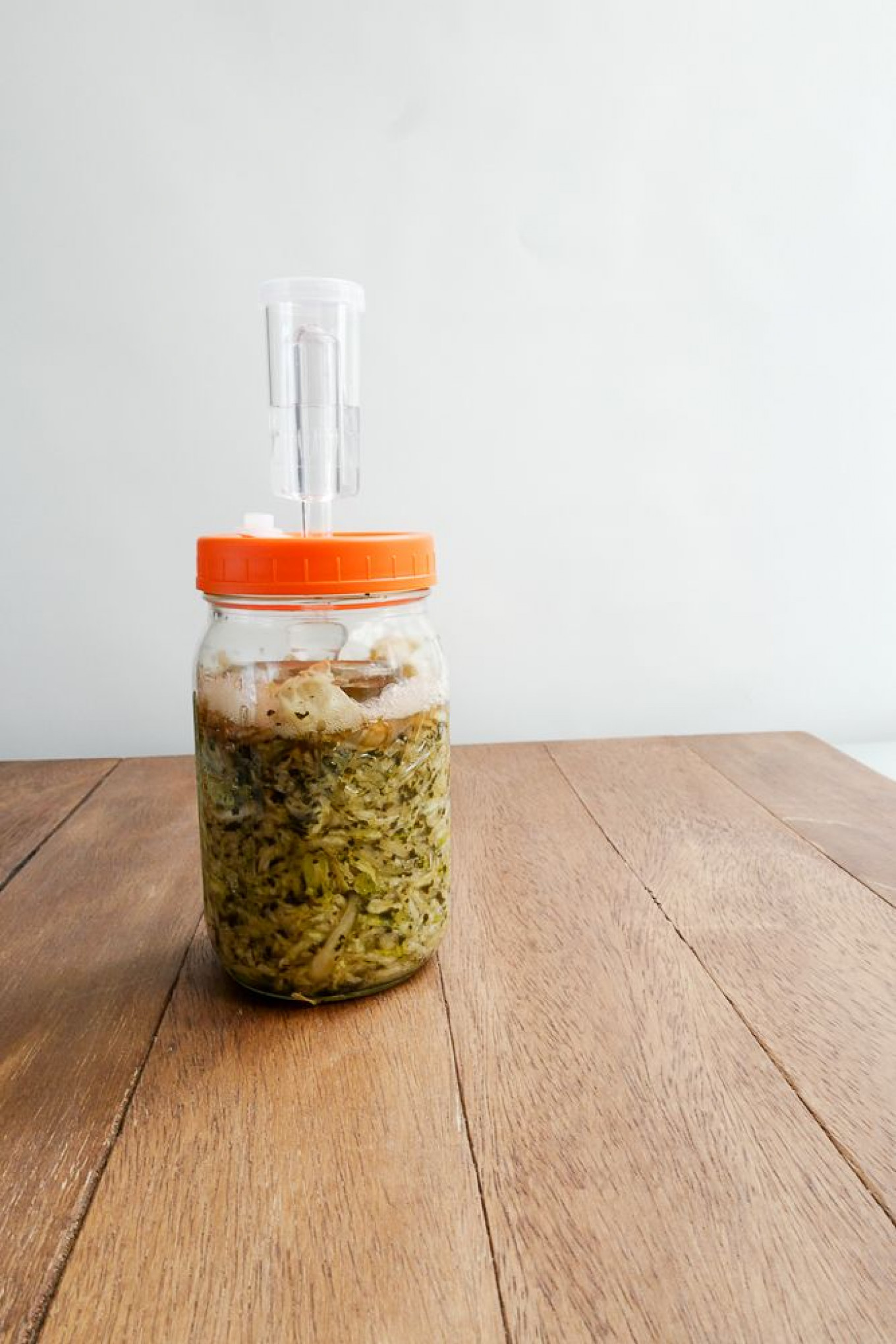
Nettle & Fennel Fermented Cabbage
Ingredients
- 1 2-lb (1 kilo) head of conventional cabbage
- 1 large fennel bulb with fronds
- 2 cups stinging nettles or ⅓ cup of dried nettles, rehydrated in 1 cup of boiling water
- 30 grams (2 Tbsp) of sea salt
- 2 bay leaves
- 2 cloves of garlic peeled and grated
Spice Mix
- 2 tsp fennel seeds
- 1 tsp allspice berries
- 1 tsp juniper berries
- 1 pinch fennel pollen (optional but recommended!)
Instructions
- Prepare the nettles, taking care to wear gloves to handle freshly picked nettles. Blanch them in boiling water for 10 seconds, then pat dry and chop finely. If using dried nettles, steep them in hot water for 1-2 hours, then drain.
- Remove the tough, outer layers of cabbage, then peel off a few large leaves and reserve for the top of the container.
- Use a sharp knife to remove the tough core of the cabbage, then cut the cabbage into quarters. Slice the cabbage into long, thin strips using a long knife or mandoline.
- Remove and discard the core of the fennel bulb and its tough outer layers and stems but keep the green fronds. Slice the remaining bulb very thinly with a mandoline.
- Toss the shredded cabbage, nettles, and fennel and its fronds with the salt and let sit for 30 minutes.
- Toast the spices over low heat until the scent intensifies, then grind them in a spice grinder or with a mortar and pestle.
- Massage the salt into the cabbage with your hands, rubbing the shredded cabbage between your fingers repeatedly until the cabbage is noticeably limper and is leaching liquid. If you have a kraut pounder or something like it, pound the cabbage to intensify this process. When you’ve done all you can, let the cabbage sit for another 45 minutes, covered with a clean towel.
- Add the spice mixture and fennel pollen if using, and toss well to combine, then pack the cabbage and any accumulated liquid into a clean container, using a pounder to press down on the cabbage, expelling any air bubbles. Leave 2 centimeters of head space and enough room for the weight.
- Cut the reserved cabbage leaves to fit the width of your container and cover the cabbage, then add the weights, lid, and airlock if using. Label your fermentation container with the date.
- Set the container to ferment in a cool, dark place. If you are using a conventional lid without an airlock, “burp” the lid every other day by cracking it and shutting it quickly. This will allow the accumulated carbon dioxide to escape and avoid an explosion.
- When 7 days have passed, taste the cabbage for desired sourness, saltiness, and intensity of flavors. Decant cabbage into clean jars and refrigerate.
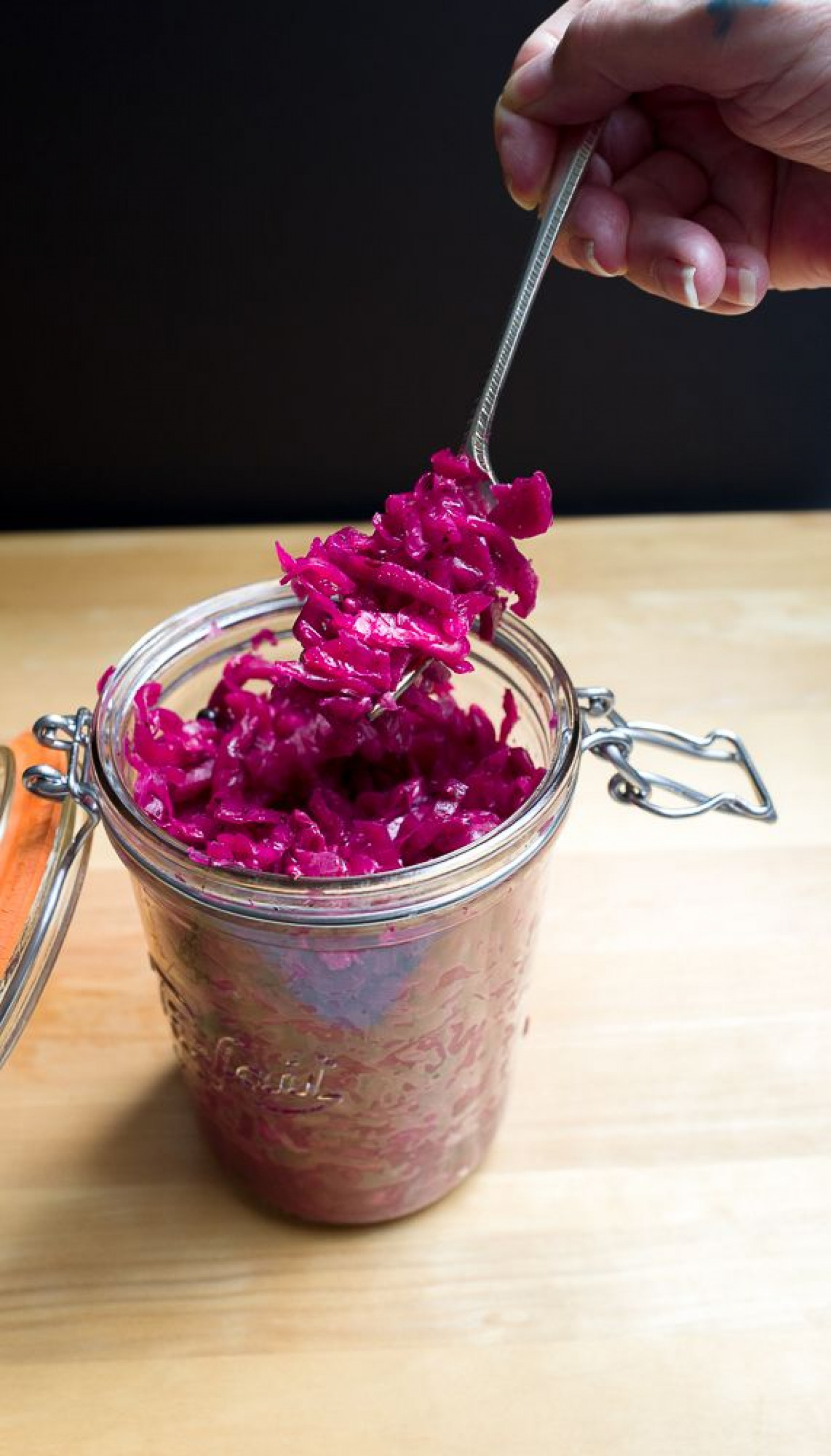
Turmeric, Quince, and Ginger Fermented Cabbage
Ingredients
- 1 2-lb (1 kilo) head of conventional cabbage
- 1 quince,* cored and sliced into matchsticks
- 1 knob ginger, grated
- 1 Tbsp fresh turmeric, peeled and grated, or 2 Tbsp of powdered turmeric
- 25 grams (1 ½ Tbsp) sea salt
- 2 bay leaves
- 2 Tbsp fresh mint, chopped
Spice Mix
- 1 tsp caraway seeds
- 1 tsp whole coriander seeds
- 1 tsp cumin
- 1 tsp dill seed
- ½ tsp black peppercorns
Instructions
- Remove the tough, outer layers of cabbage, then peel off a few large leaves and reserve for the top of the container.
- Use a sharp knife to remove the tough core of the cabbage, then cut the cabbage into quarters. Slice the cabbage into long, thin strips using a long knife or mandoline.
- Toss the shredded cabbage and quince matchsticks with the salt, ginger, and turmeric and let sit for 30 minutes.
- Toast the spices over low heat until their scent intensifies, then grind them in a spice grinder or with a mortar and pestle.
- Massage the salt into the cabbage with your hands, rubbing the shredded cabbage between your fingers repeatedly until the cabbage is noticeably limper and is leaching liquid. If you have a kraut pounder or something like it, pound the cabbage to intensify this process. When you’ve done all you can, let the cabbage sit for another 45 minutes, covered with a clean towel.
- Add the spice mixture and mint to the cabbage and toss well to combine. Pack the cabbage mixture, and any accumulated liquid, and bay leaves, into a clean container, using a pounder to press down on the cabbage, expelling any air bubbles. Leave 2 centimeters of head space and enough room for the weight.
- Cut the reserved cabbage leaves to fit the width of your container and cover the cabbage, then add the weights, lid, and airlock if using. Label your fermentation container with the date.
- Set the container to ferment in a cool, dark place. If you are using a conventional lid without an airlock, “burp” the lid every other day by cracking it and shutting it quickly. This will allow the accumulated carbon dioxide to escape and avoid an explosion.
- When 7 days have passed, taste the cabbage for desired sourness, saltiness, and intensity of flavors. Decant cabbage into clean jars and refrigerate.
*If you can’t find quince, a crisp, tart apple is an excellent substitute. If you are after something even more exotic, use 1-½ cups of fresh or canned pineapple cut into thin matchsticks. The result is a vibrantly colored cabbage that makes a marvelous salad when combined with cilantro, bell peppers, and scallions.
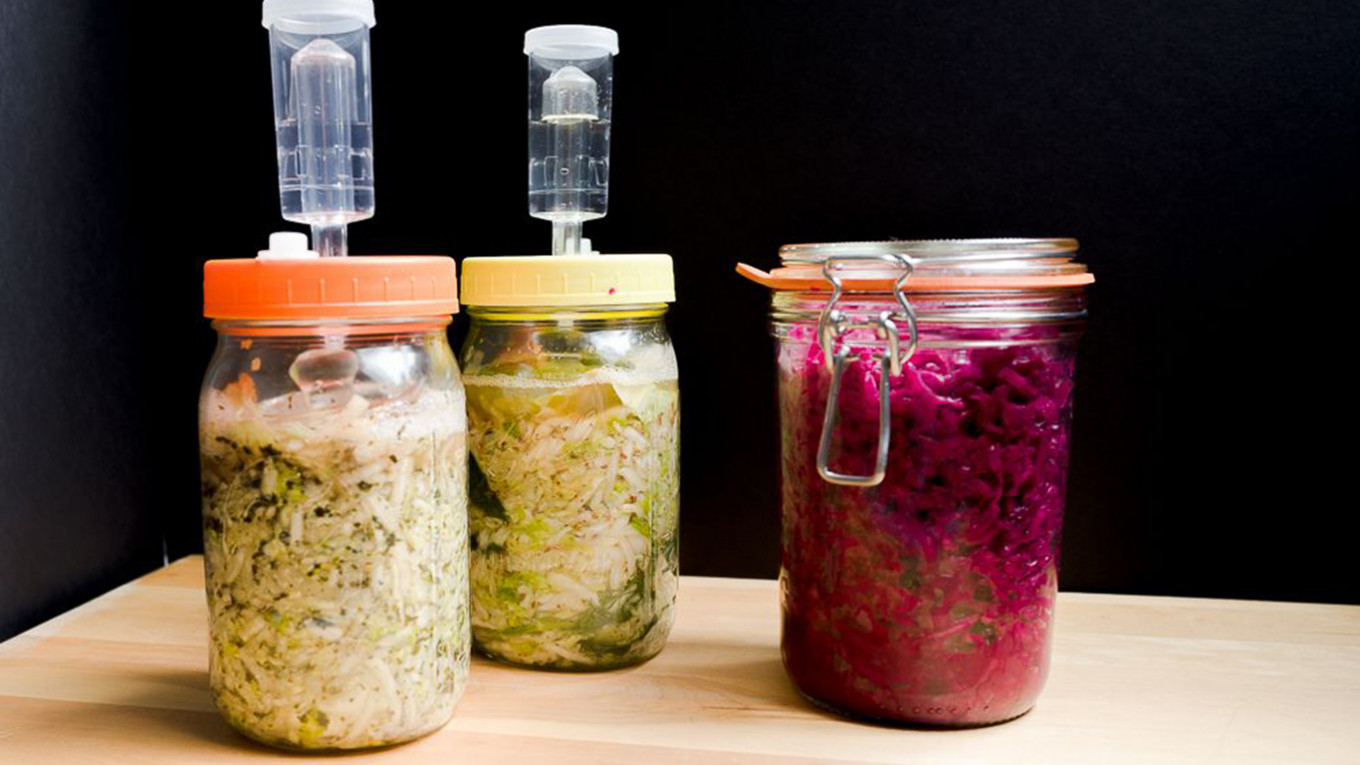
Fermented Red Cabbage with Beet and Ginger
This is a wonderfully festive, jewel-toned cabbage that pairs very well with pork and ham.
Ingredients
- 2 lbs. (1 kilo) shredded red cabbage (about 1 ½ red cabbage heads)
- 1 large purple beet, peeled and grated
- 25 grams (1 ½ Tbsp) sea salt
- 2 tsp grated ginger
- 2 bay leaves
Spice Mix
- 1 tsp whole coriander seeds
- 1 tsp allspice berries
- ½ tsp of red pepper
- 1 tsp juniper berries
Instructions
- Remove the tough, outer layers of cabbage, then peel off a few large leaves and reserve for the top of the container.
- Use a sharp knife to remove the tough core of the cabbage, then cut the cabbage into quarters. Slice the cabbage into long, thin strips using a long knife or mandoline.
- Toss the shredded cabbage, grated beets, and ginger with the salt and let sit for 30 minutes.
- Toast the spices over low heat until their scent intensifies, let them cool, then grind them in a spice grinder or with a mortar and pestle.
- Massage the salt into the cabbage with your hands, rubbing it between your fingers repeatedly until the cabbage is noticeably limper and is leaching liquid. If you have a kraut pounder or something like it, pound the cabbage to intensify this process. When you’ve done all you can, let the cabbage sit for another 45 minutes, covered with a clean towel.
- Add the spice mixture and toss well to combine. Pack the cabbage and any accumulated liquid and bay leaves into a clean container, using a pounder to press down on the cabbage, expelling any air bubbles. Leave 2 centimeters of head space and enough room for the weight.
- Cut the reserved cabbage leaves to fit the width of your container and cover the cabbage, then add the weights, lid, and airlock if using. Label your fermentation container with the date.
- Set the container to ferment in a cool, dark place. If you are using a conventional lid without an airlock, “burp” the lid every other day by cracking it and shutting it quickly. This will allow the accumulated carbon dioxide to escape and avoid an explosion.
- When 7 days have passed, taste the cabbage for desired sourness, saltiness, and intensity of flavors. Decant cabbage into clean jars and refrigerate.
A Message from The Moscow Times:
Dear readers,
We are facing unprecedented challenges. Russia's Prosecutor General's Office has designated The Moscow Times as an "undesirable" organization, criminalizing our work and putting our staff at risk of prosecution. This follows our earlier unjust labeling as a "foreign agent."
These actions are direct attempts to silence independent journalism in Russia. The authorities claim our work "discredits the decisions of the Russian leadership." We see things differently: we strive to provide accurate, unbiased reporting on Russia.
We, the journalists of The Moscow Times, refuse to be silenced. But to continue our work, we need your help.
Your support, no matter how small, makes a world of difference. If you can, please support us monthly starting from just $2. It's quick to set up, and every contribution makes a significant impact.
By supporting The Moscow Times, you're defending open, independent journalism in the face of repression. Thank you for standing with us.
Remind me later.



